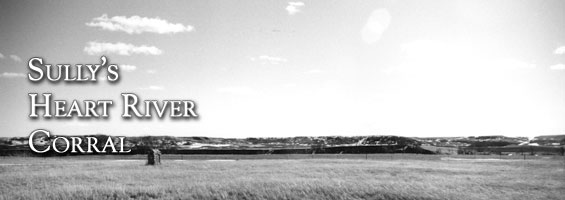We’ve launched a new web portal! Visit findhistory.nd.gov to search our collections.

On July 19, 1864, General Alfred Sully led his expedition away from the skeletal outlines of the newly established Fort Rice with a wagon train of immigrants en route to the newly discovered gold fields of Montana (see Fort Rice). To continue his pursuit of the Sioux, Sully left the immigrants and a military guard behind at the Heart River. The frightened gold seekers dug rifle pits to protect the wagon train from attack. Remnants of these pits are still visible twenty miles southeast of Richardton, Stark County.
The purpose of the military expedition was to scout the Cannonball River for signs of the Sioux who had escaped from the confrontation at Whitestone Hill (see Whitestone Hill), but the troops were given the added responsibility of protecting the immigrant train. This angered Sully because the train’s slow-moving ox-teams impeded the movements of his troops. He also resented the loss of the four hundred soldiers he felt obliged to leave behind for their protection.
Called the “Tom Holmes Expedition” after the man who had organized it, the immigrant train had 123 covered wagons drawn by teams of oxen. The wagons carried between 250 and 500 men, women, and children. A “captain-general” led the train, which was grouped into six divisions, each under its own wagonmaster. A “court” had been elected to deal with any legal matters, and a sheriff, postmaster, and a chaplain served other communal needs.
As the column marched west, rumors of Indian sightings and impending dangers kept the party watchful. Eventually, the expedition’s scouts reported a large encampment of Sioux at Killdeer Mountain, fifty miles north of the current route.
On the evening of July 24, the expedition reached the Heart River. Sully decided to leave the immigrant train and his own supply train beside the Heart River under the protection of a strong guard. The remainder of the expedition would march quickly to the reported Indian village before the Sioux could escape. Accordingly, July 25 was spent resting men and animals, redistributing supplies, and preparing for the march ahead.
After the departure of the troops on July 26, the people of the wagon train spent five anxious days awaiting the return of Sully’s forces. First, they began to fear that a small force of Indians would decoy Sully far away so that the main force could wipe them out and capture the army’s supplies. Therefore, the party crossed to the north side of the river and formed the wagons into a corral surrounded by rifle pits and entrenchments. One day the expedition’s mules stampeded but were recaptured. On another occasion, nervous guards rousted the men out of their beds at about 11:00 p.m. and called them to the rifle pits where they stood watch for the rest of the night. As a final precaution, the defenders made a “cannon” by hollowing a large log and reinforcing it with iron bands. Several practice shots proved the cannon worked and all felt a bit safer.
Sully’s troops fought the Lakotas, Dakotas, and Yanktonais at Killdeer Mountain and returned to the Heart River encampment on July 31 (see Killdeer Mountain Battlefield). Upon their return, the troops spent two days resting while the officers wrote their battle reports and planned the next move. On August 3, Sully’s expedition, troops, train and all, again started westward to complete the summer’s planned campaign.
Sully’s Heart River Corral State Historic Site is small, undeveloped, and lacks a parking lot, directional signs, or any other facilities. It does feature a pristine setting and original rifle pits. A site marker sits in a pasture one-eighth mile east of the road. The rifle pits are to the north and to the east of the marker.
SHSND Address:
612 East Boulevard Ave.
Bismarck, North Dakota 58505
Get Directions
SHSND Hours:
Museum Store: 8am - 5pm M-F; Sat. & Sun. 10am - 5pm.
State Archives: 8am - 4:30pm., M-F, except state holidays, and 2nd Sat. of each month, 10am - 4:30 pm.
State Historical Society offices: 8am - 5pm M-F, except state holidays.
Contact SHSND:
phone: 701.328.2666
email: history@nd.gov